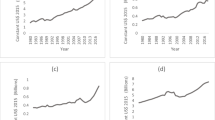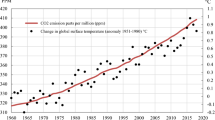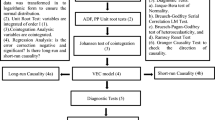Abstract
This paper investigates the validity of the Environmental Kuznets Curve (EKC) hypotheses for agriculture. The impact of precipitations on soil CO2 emissions is incorporated in the EKC hypothesis to assess the so-called “Birch effect phenomenon.” Through an autoregressive distributed lag (ARDL) bound test modeling and using annual data from 1975 to 2014, we examine the short- and long-term relationships between net agricultural values added per rural capita, energy consumption, precipitation and agricultural CO2 emissions in Tunisian agriculture. We then used the nonlinear version of ARDL (NARDL) to examine the asymmetric effect of precipitations on CO2 emissions. The EKC assumption is validated in favor of the agricultural sector in both short and long-run associations, suggesting the adoption of cleaner production practices. The results also indicate that precipitation increases soil CO2 emissions in the short-term as well as in the long-term, confirming the Birch effect phenomenon and reflecting the specificity of the Tunisian climate-ecosystem. The asymmetric findings provide evidence of different CO2 emissions response to negative and positive shocks of precipitations in terms of magnitude, whereas the energy use in agriculture is found not to affect CO2 emissions when switching from linear to a nonlinear model. As recommendations, promoting the agricultural productivity and preserving farmland in Tunisia should be among the main actions for any agricultural policy to improve economic growth and to achieve environmental sustainability.




Similar content being viewed by others
References
Alamdarlo, H. N. (2016). Water consumption, agriculture value added and carbon dioxide emission in Iran, environmental Kuznets curve hypothesis. International Journal of Environmental Science and Technology, 13(8), 2079–2090.
Arouri, M. E. H., Ben Youssef, A., Mhenni, H., & Rault, C. (2012). Energy consumption, economic growth and CO2 emissions in Middle East and North African countries. Energy Policy, 45, 342–349.
Attiaoui, I., Toumi, H., Ammouri, B., & Gargouri, I. (2017). Causality links among renewable energy consumption, CO2 emissions, and economic growth in Africa: Evidence from a panel ARDL-PMG approach. Environmental Science and Pollution Research, 24, 13036–13048.
Aydin, C., & Esen, Ö. (2018). Does the level of energy intensity matter in the effect of energy consumption on the growth of transition economies? Evidence from dynamic panel threshold analysis. Energy Economics, 69, 185–195.
Boufateh, T. (2019). The environmental Kuznets curve by considering asymmetric oil price shocks: Evidence from the top two. Environmental Science and Pollution Research, 26(1), 706–720.
Boufateh, T., & Sadaoui, Z. (2020). Do asymmetric financial development shocks matter for CO2 emissions in Africa? A nonlinear panel ARDL–PMG approach. Environmental Modeling & Assessment, 25(6), 809–830.
Brown, R. L., Durbin, J., & Evans, J. M. (1975). Techniques for testing the constancy of regression relations over time. Journal of the Royal Statistical Society Serie B, 37, 149–163. https://www.jstor.org/stable/2984889
Charfeddine, L. (2017). The impact of energy consumption and economic development on ecological footprint and CO2 emissions: Evidence from a Markov Switching Equilibrium Correction Model. Energy Economics, 65, 355–374.
Chi, Y., Yang, P., Ren, S., Ma, N., Yang, J., & Xu, Y. (2020). Effects of fertilizer types and water quality on carbon dioxide emissions from soil in wheat-maize rotations. Science of The Total Environment, 698, 134010.
Coderoni, S., & Esposti, R. (2013). Is there a long-term relationship between agricultural GHG emissions and productivity growth? A dynamic panel data approach. Environmental and Resource Economics, 58(2), 273–302.
Colomb, V., Bernoux, M., Bockel, L., Chotte, J. L., Martin, S., Martin-Phipps, C., Mousset, J., Tinlot, M., & Touchmoulin, O. (2012). Review of GHG calculators in agriculture and forestry sectors. A Guideline for Appropriate Choice and Use of Landscape Based. https://www.fao.org/fileadmin/templates/ex_act/pdf/Review_existingGHGtool_GB.pdf
Cruz-Martínez, K., Rosling, A., Zhang, Y., Song, M., Andersen, G. L., & Banfield, J. F. (2012). Effect of rainfall-induced soil geochemistry dynamics on grassland soil microbial communities. Applied and Environment Microbiology, 78, 7587–7595.
Dong, K., Sun, R., & Hochman, G. (2017). Do natural gas and renewable energy consumption lead to less CO2 emission? Empirical evidence from a panel of BRICS countries. Energy, 141, 1466–1478.
Doughty, C. E., Metcalfe, D., Girardin, C., Amézquita, F. F., Cabrera, D. G., Huasco, W. H., et al. (2015). Drought impact on forest carbon dynamics and fluxes in Amazonia. Nature, 519, 78–82.
Evans, S., Dieckmann, U., Franklin, O., & Kaiser, C. (2016). Synergistic effects of diffusion and microbial physiology reproduce the Birch effect in a micro-scale model. Soil Biology & Biochemistry, 93, 28–37.
Fahmy, T. Y. A., Fahmy, Y., Mobarak, F., et al. (2020). Biomass pyrolysis: Past, present, and future. Environment, Development and Sustainability, 22, 17–32. https://doi.org/10.1007/s10668-018-0200-5
FAO. (2015). Tunisie: Analyse de la filière oléicole. https://www.fao.org/publications/card/en/c/fbe55179-ed61-427a-af6a-fb0c21bfc54e/
Fraser, F. C., Corstanje, R., Deeks, L. K., Harris, J. A., Pawlett, M. P., Todman, L. C., Whitmore, A. P., & Ritz, K. (2016). On the origin of carbon dioxide released from rewetted soils. Soil Biology and Biochemistry, 101, 1–5.
Gebremichael, A., Orr, P. G., & Osbonrne, B. (2019). The impact of wetting intensity on soil CO2 emissions from a coastal grassland ecosystem. Geoderma, 343, 86–96.
Gokmenoglu, K. K., & Taspinar, N. (2018). Testing the agriculture-induced EKC hypothesis: The case of Pakistan. Environmental Science and Pollution Research, 25, 22829–22841.
Grossman, G. M., & Krueger, A. B. (1995). Economic growth and the environment. The Quarterly Journal of Economics, 110(2), 353–377.
Hao, Y., Kang, X., Wu, X., Cuia, X., Liua, W., Zhanga, H., Li, Y., Wang, Y., Xuc, Z., & Zhao, H. (2013). Is frequency or amount of precipitation more important in controlling CO2 fluxes in the 30-year-old fenced and the moderately grazed temperate steppe? Agriculture, Ecosystems and Environment, 171, 63–71.
Harper, C. W., Blair, J. M., Fay, P. A., Knapp, A. K., & Carlisle, J. D. (2005). Increased rainfall variability and reduced rainfall amount decreases soil CO2 flux in a grassland ecosystem. Global Change Biology, 11, 322–334.
IPCC, (2014). Working Group III contribution to the IPCC Fifth Assessment Report. Retrieved June 10, 2017, from www.ipcc.ch/pdf/unfccc/sbsta40/AR5WGIII_Tubiello_140606.pdf
Jebli, M. B., & Ben Youssef, S. (2015). The environmental Kuznets curve, economic growth, renewable and non-renewable energy, and trade in Tunisia. Renewable and Sustainable Energy Reviews, 47, 173–185.
Jebli, M. B., & Ben Youssef, S. (2016). Renewable energy consumption and agriculture: evidence for cointegration and Granger causality for Tunisian economy. International Journal of Sustainable Development & World Ecology, 24(2), 149–158.
Karhu, K., Auffret, M. D., Dungait, J. A. J., Hopkins, D. W., Prosser, J. I., Singh, B. K., et al. (2014). Temperature sensitivity of soil respiration rates enhanced by microbial community response. Nature, 513, 81–84. https://www.nature.com/articles/nature13604
Kim, D. G., Vargas, R., Bond-Lamberty, B., & Turetsky, M. R. (2012). Effects of soil rewetting and thawing on soil gas fluxes: A review of current literature and suggestions for future research. Biogeosciences, 9, 2459–2483. https://doi.org/10.5194/bg-9-2459-2012
Kim, Y., Nishina, K., Chae, N., Park, S., Yoon, Y., & Lee, B. (2014). Constraint of soil moisture on CO2 efflux from tundra lichen, moss, and tussock in Council, Alaska, using a hierarchical Bayesian model. Biogeosciences, 11, 5567–5579.
Koca, D., Smith, B., & Sykes, T. M. (2006). Modelling regional climate change effects on Potential Natural Ecosystems in Sweden. Climatic Change, 78, 381–406.
Lado-Monserrat, L., Lull, C., Bautista, I., Lidon, A., & Herrera, R. (2014). Soil moisture increment as a controlling variable of the “Birch effect”. Interactions with the pre-wetting soil moisture and litter addition. Plant and Soil, 379, 21–34.
Lee, J., & Strazicich, M. C. (2003). Minimum Lagrange Multiplier unit root test with two structural breaks. The Review of Economics and Statistics, 85, 1082–1089. https://doi.org/10.1162/003465303772815961
Li, J., Li, H., Zhang, Q., Shao, H., Gao, C., & Zhang, X. (2019). Effects of fertilization and straw return methods on the soil carbon pool and CO2 emission in a reclaimed mine spoil in Shanxi Province, China. Soil and Tillage Research, 195, 104361.
Lin, B., & Xu, B. (2018). Factors affecting CO2 emissions in China’s agriculture sector: A quantile regression. Renewable and Sustainable Energy Reviews, 94(2018), 15–27.
Liu, X., Zhang, S., & Bae, J. (2017). The impact of renewable energy and agriculture on carbon dioxide emissions: Investigating the environmental Kuznets curve in four selected ASEAN countries. Journal of Cleaner Production, 164, 1239–1247.
Mobarak, F., Fahmy, Y., & Schweers, W. (1982). Production of phenols and charcoal from bagasse by a rapid continuous pyrolysis process. Wood Science and Technology, 16, 59–66.
Narayan, P. K., & Narayan, S. (2010). Carbon dioxide and economic growth: Panel data evidence from developing countries. Energy Policy, 38, 661–666.
Pakrooh, P., Hayati, B., Pishbahar, E., Nematian, J., & Brännlund, E. R. (2020). Focus on the provincial inequalities in energy consumption and CO2 emissions of Iran’s agriculture sector. Science of the Total Environment, 715, 137029. https://doi.org/10.1016/j.scitotenv.2020.137029
Pareja-Sánchez, E., Cantero-Martínez, C., Álvaro-Fuentes, J., & Plaza-Bonilla, D. (2019). Tillage and nitrogen fertilization in irrigated maize: Key practices to reduce soil CO2 and CH4 emissions. Soil and Tillage Research, 191, 29–36. https://doi.org/10.1016/j.still.2019.03.007
Perron, P. (1997). Further evidence on breaking trend functions in macroeconomic variables. Journal of Economics, 80, 355–385.
Pesaran, M. H., Shin, Y., & Smith, R. J. (2001). Bounds testing approaches to the analysis of level relationships. Journal of Applied Econometrics, 16(3), 289–326.
Presno, M. J., Landajo, M., & González, P. F. (2018). Stochastic convergence in per capita CO2 emissions. An approach from nonlinear stationarity analysis. Energy Economics, 70, 563–581.
Qiu, L., Hao, M., & Wu, Y. (2017). Potential impacts of climate change on carbon dynamics in a rain-fed agro-ecosystem on the Loess Plateau of China. Science of the Total Environment, 577, 267–278.
Richmond, A. K., & Kaufmann, R. K. (2006). Is there a turning point in the relationship between income and energy use and/or carbon emissions? Ecological Economics, 56(2), 176–189. https://doi.org/10.1016/j.ecolecon.2005.01.011
Rey, A., Oyonarte, C., Moran-Lopez, T., Raimundo, J., & Pegoraro, E. (2017). Changes in soil moisture predict soil carbon losses upon rewetting in a perennial semiarid steppe in SE Spain. Geoderma, 287, 135–146.
Schmitt, A., Glaser, B., Borken, W., & Matzner, E. (2010). Organic matter quality of a forest soil subjected to repeated drying and different re-wetting intensities. European Journal of Soil Science, 61, 243–254.
Shahbaz, M., Sbia, R., Hamdi, H., & Ozturk, I. (2014). Economic growth, electricity consumption, urbanization and environmental degradation relationship in United Arab Emirates. Ecological Indicators, 45, 622–631.
Shin, Y., Yu, B., & Greenwood-Nimmo, M. (2014). Modelling asymmetric cointegration and dynamic multipliers in a nonlinear ARDL framework. In R. C. Sickles & W. C. Horrace (Eds.), Festschrift in Honor of Peter Schmidt: Econometric Methods and Applications (pp. 281–314). New York, NY: Springer New York. https://doi.org/10.1007/978-1-4899-8008-3_9
Stern, D. I. (1999). Attributing changes in global sulfur emissions. Working papers in ecological economics 9902, Australian National University, Centre for Resource and Environmental Studies, Ecological Economics no 9902.
Wang, J., Liu, Q. Q., Chen, R. R., Liu, W. Z., & Sainju, U. M. (2015). Soil carbon dioxide emissions in response to precipitation frequency in the Loess Plateau, China. Applied Soil Ecology, 96, 288–295.
Wang, Y., & Shen, N. (2016). Agricultural environmental efficiency and agricultural environmental Kuznets curve based on technological gap: The case of China. Polish Journal of Environmental Studies, 25(3), 1293–1303.
Waring, B. G., & Powers, J. S. (2016). Unravelling the mechanisms underlying pulse dynamics of soil respiration in tropical dry forests. Environmental Research Letters, 11, 105005.
Wei, X., Zhang, Y., Liu, J., Gao, H., Fan, J., Jia, X., Cheng, J., Shao, M., & Zhang, X. (2016). Response of soil CO2 efflux to precipitation manipulation in semiarid grassland. Journal of Environmental Science, 45, 207–214.
World Bank. (2016). World development indicators. Retrieved June 10, 2017, from http://data.worldbank.org.cn/data-catalog/world-development-indicators
Wu, L., Su, Y., & Zhang, Y. M. (2012). Effects of simulated precipitation on apparent carbon flux of biologically crusted soils in the Gurbantunggut Desert in Xinjiang, Northwestern China. Acta Ecologica Sinica, 32, 4103–4113.
Xu, X., & Luo, X. (2012). Effect of wetting intensity on soil GHG fluxes and microbial biomass under a temperate forest floor during dry season. Geoderma, 170, 118–126.
Yu, Y., Jiang, T., Li, S., Li, X., & Gao, D. (2020). Energy-related CO2 emissions and structural emissions’ reduction in China’s agriculture: An input–output perspective. Journal of Cleaner Production, 276, 124169.
Zafeiriou, E., & Azam, M. (2017). CO2 emissions and economic performance in EU agriculture: Some evidence from Mediterranean countries. Ecological Indicators, 81, 104–114.
Zafeiriou, E., Sofios, S., & Partalidou, X. (2017). Environmental Kuznets curve for EU agriculture: Empirical evidence from new entrant EU countries. Environmental Science and Pollution Research, 24(18), 15510–15520.
Zhang, L., Pang, J., Chen, X., & Lu, Z. (2019). Carbon emissions, energy consumption and economic growth: Evidence from the agricultural sector of China’s main grain-producing areas. Science of the Total Environment, 665, 1017–1025. https://doi.org/10.1016/j.scitotenv.2019.02.162
Author information
Authors and Affiliations
Corresponding author
Additional information
Publisher's Note
Springer Nature remains neutral with regard to jurisdictional claims in published maps and institutional affiliations.
Appendix
Appendix
1.1 Nomenclature
1.1.1 Abbreviations
- IPCC:
-
Intergovernmental Panel on Climate Change
- FAOSTAT:
-
Food and Agriculture Organization Corporate Statistical
- NIMT:
-
National Institute of Meteorology of Tunisia
- USD:
-
American dollar
- EKC:
-
Environmental Kuznets curve
- SOC:
-
Soil organic carbon
- GHG:
-
Greenhouse
- CO2:
-
The agricultural dioxide carbonemissions
- CH4:
-
Global methane emissions
- N2O:
-
Nitrous dioxide emissions
- ARDL:
-
Autoregressive distributed lag model
- NARDL:
-
Nonlinear autoregressive distributed lag model
- ECM:
-
Error correction model
- ECT:
-
Error correction term
1.1.2 Symbols
- ∆:
-
The first difference operator
- GDP:
-
The net agricultural value-added per rural capita
- GDP2:
-
The square of the net agricultural value-added per rural capita
- AEC:
-
The per capita agricultural energy consumption
- UAL:
-
Used agricultural land
- Prec:
-
Precipitations
- \({PREC}_{t}^{+}\) :
-
Positive partial sum
- \({PREC}_{t}^{-}\) :
-
Negative partial sum
- TB1:
-
Year of first structural break
- TB2:
-
Year of second structural break
- AIC:
-
Akaike Information Criterion
- SBC:
-
Schwarz Bayesian criterion
- OLS:
-
Ordinary least square
- CUSUM:
-
Cumulative sum
- CUSUMSQ:
-
Cumulative sum of squares
See Fig. 5 and Tables 6, 7, 8 and 9.
Rights and permissions
About this article
Cite this article
Boufateh, T., Attiaoui, I. & Kahia, M. Does asymmetric birch effect phenomenon matter for environmental sustainability of agriculture in Tunisia?. Environ Dev Sustain 25, 4237–4267 (2023). https://doi.org/10.1007/s10668-022-02241-6
Received:
Accepted:
Published:
Issue Date:
DOI: https://doi.org/10.1007/s10668-022-02241-6





